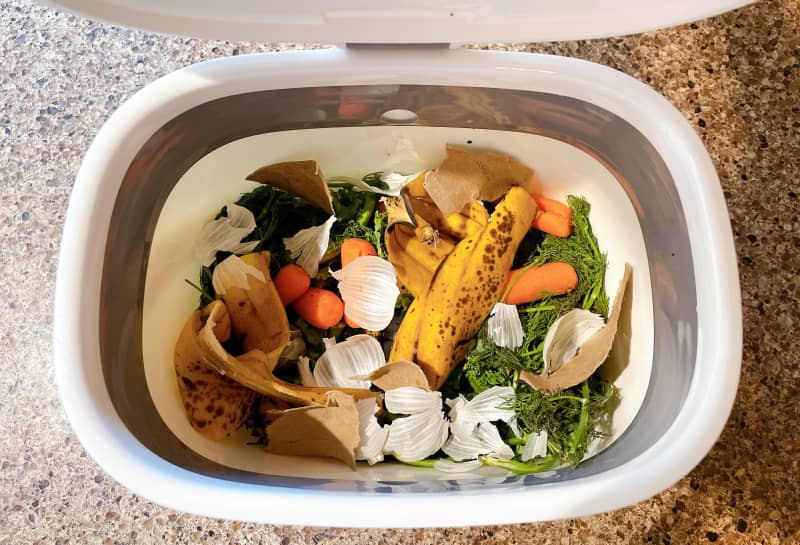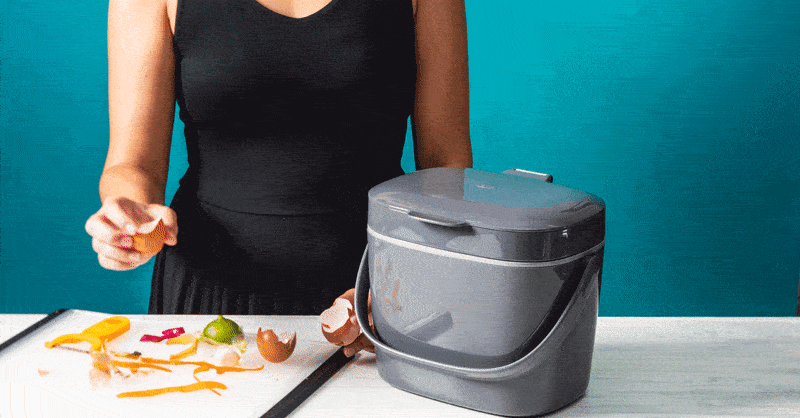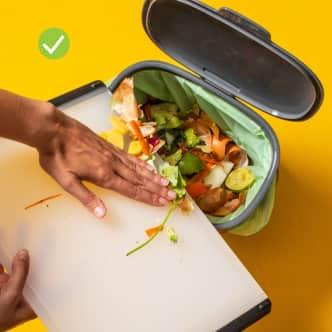While composting is a dirty job, a countertop compost bin allows you to neatly store food scraps until you can transfer them to a larger setup. Our favorite is the OXO Good Grips Easy-Clean Compost Bin - 1.75 Gal. It is a breeze to clean, contains odors, has a sturdy handle, and sports a convenient flip-open lid that can detach and also helps secure liner bags. We also liked the Exaco Eco 2000 Kitchen Compost Pail, a spacious, no-frills model that is perfect for larger households. Our favorite stainless-steel model is the streamlined, easy-to-clean Package Free Compost Bin Container, a good choice for those who want to stay away from plastic entirely.

Things can get messy fast when you’re cooking—especially if you’re doing a lot of prep work like peeling carrots, stemming herbs, or dicing onions. Those scraps can clutter your workspace and all too often end up in the trash. In fact, Americans contribute billions of pounds of food to landfills every year. Composting those scraps can divert a lot of waste from landfills and cut down on the resulting methane emissions.
Of course, composting is not new. Farmers and gardeners have utilized decomposed organic matter to nourish their fields and crops for millennia. This age-old practice has become increasingly prevalent in the homes of non-farmers, too. According to the Environmental Protection Agency, the amount of food scraps and yard trimming composted increased by 6.4% from 2015 to 2018. Today, many cities across the nation are rolling out municipal composting programs.

Whether you have space for a backyard composter or you live in a city that offers curbside pickup, you need a countertop receptacle to collect your food scraps and to transport the scraps when the bin is full. Countertop compost bins are often more aesthetically pleasing than plastic utility buckets or plastic bags, and the best models strike the perfect balance between design and functionality. Some also offer helpful features that make storing scraps easier, including filters intended to contain smells. Most models can be used with or without biodegradable bags (we tested ours with 2.6 gallon SuperBio compostable bags, a popular brand that’s widely available via online retailers). The types of bins we tested are perfect for storing food scraps but are not meant for turning scraps into compost.
What to Look For
- Lightweight Models: Models weighing more than 4 pounds were hard to lift, both when empty and when full. We preferred bins that were lighter—around 2 pounds or less when empty.
- Secure Handles: If you’re carrying heaps of rotting organic matter, the last thing you want is to spill it all over your kitchen floor due to a flimsy handle. Our favorite bins had relatively secure handles that were firmly connected to the sides of the bins and remained attached, no matter the load.


Handles firmly attached to the side of the bin allowed us to carry and empty the bins securely and with ease. However, loosely attached hook-style handles were prone to falling off and made transporting the bins cumbersome.
- Flip-Top Lids: When our hands were wet or dirty from cracking eggs or performing other common cooking tasks, we liked being able to open lids with the back of our hand. We also appreciated lids that stayed open when we wanted them to and those that were easy to close when we were done adding scraps.

- Wide Openings: Dumping a heap of peels or scraping off a cutting board was much easier with bins that had large openings. The opening of our winning models measured from 6.25 to 7 inches wide, compared to just 5 inches for our least favorite.
- Models Without Nooks and Crannies: Some of the bins had more crevices than others, including narrow slits where the lid secures to the bin. Gunk and mold tended to get stuck in these nooks and crannies. We liked bins that allowed us to get a sponge or scrub brush into every corner and were easy to dry.

Nice to Have
- Detachable Lids: Models with detachable lids were easier to clean because we could scrub each component separately.
- Bag-Gripping Collars: A few models had rings or collars built into their lids that held compostable bags in place.
What to Avoid
- Narrow Openings: When we dumped scraps or coffee grounds into bins with narrow openings, we often made a mess on the counter.


Models with wide openings, measuring at least 6.25 inches, allowed us to dump scraps directly into the bins without making a mess—bins with small openings, around 5 inches or less, caused scraps to spill over the side.
- Ceramic Models: It’s best to avoid ceramic bins since they’re usually heavy and fragile. They can fall and shatter while being handled or cleaned.
- Loose Lids: Lids that just rested on top of bins felt like open invitations for fruit flies.
- Loose Hook-Style Handles: Loosely attached hook-style handles were prone to falling off, which could spell disaster while transporting a bin to be dumped.
Other Considerations
- Capacity and Shape: If you eat lots of fresh foods or have a big household, you probably want a larger model that can hold at least 2 gallons. If you have a small household or rarely cook, a smaller bin will likely be best.
- Filters: Some models come with filters under their lids that are intended to trap odors. Most manufacturers recommend replacing them every two to three months. In our tests, models with filters didn’t contain smells any better than models without filters. If you like having a filter, we found several models with them to recommend.
- Compostable Bags: Using a compostable bag in your bin can make cleanup easier. However, all bags are not created equal. Some of the models included bags that ripped when we unfolded them. For consistency, we ordered 2.6 Gallon Compostable Food Scrap Bags and tested each model with them. We found these bags to be much stronger. Be sure to check with your local or municipal composting program before buying compostable bags to make sure they allow them to be thrown out with your compost.
The Tests
- Use the bins daily for a week in a home kitchen
- Test the compatibility of each model with 2.6 Gallon Compostable Food Scrap Bags
- Where applicable, install the filter according to manufacturer’s instructions
- Transfer fruit and vegetable peels from a cutting board to the bin
- Make coffee and transfer wet coffee grounds into bin
- Place half an onion in each bin and set aside for 8 hours, then sniff for odors every 12 hours for a week
- Smear with 1 tablespoon each of coffee grounds, mustard, and ketchup (taking care to get in the nooks and crannies and on the filter if applicable) and set aside overnight, then wash according to manufacturer’s instructions
- Open and close the lid 100 times
- Drop a heavy item in the bin to see if the compostable bag stays tightly attached
- Swing back and forth by the handle 100 times
- Wash and dry an additional 10 times
How We Rated
- Ease of Use: We evaluated how easy the bins were to integrate into our kitchen routines, including how much they could hold and whether they were easy to open with dirty hands while cooking.
- Odor Containment: We assessed how well and how long the bins controlled smells over the course of a week.
- Emptying and Cleanup: We tested how easy it was to transport the bins when they were full, to empty them, and to clean and dry them.
- Durability: We noted how well the bins held up to use and minor abuse.












